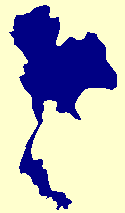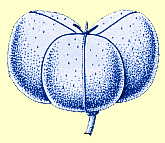
Flora of Thailand
Euphorbiaceae

 |
|
 |
Goto on this page:
L., Sp. Pl.: 1008. 1753; Mόll. Arg. in DC., Prodr. 15, 2: 1229. 1866; Pax & K.Hoffm. in Engl., Pflanzenr. IV.147.v: 271. 1912; Pax & K.Hoffm. in Engl. & Harms, Nat. Pflanzenfam. ed. 2, 19c: 206. 1931; G.L.Webster, Ann. Miss. Bot. Gard. 81: 125. 1994; Radcl.-Sm., Gen. Euphorbiacearum: 397. 2001; Esser in Welzen & Chayam., Fl. Thailand 8, 2: 338. 2007; G.L.Webster in Kubitzki, Fam. Gen. Vasc. Pl. 11: 199, Fig. 45. 2014.
Large trees, monoecious; stems often with woody spines, branching usually in whorls; latex white. Indumentum consisting of multicellular, unbranched hairs. Stipules large, ovate, eglandular. Leaves alternate, petiole long, with a pair of apical glands; blade simple, symmetric, base cordate, margin serrate to nearly entire, pubescent at least below; eglandular; venation pinnate, not triplinerved, tertiary veinlets distinct, percurrent. Inflorescences terminal or axillary, unbranched, elongate, with pistillate and staminate flowers usually separated, the staminate part catkin-like with a long stalk; bracts eglandular, united into a membranaceous, tunica-like sheath of the buds; flowers one per bract. Flowers actinomorphic, pedicellate, without petals or disc. Staminate flowers pubescent; sepals completely fused, cupulate; stamens 10 or more, filaments longer than the anthers, completely fused, the anthers therefore in rings or glomerules without visible filaments, anthers 2-locular, basifixed; pistillode absent. Pistillate flowers pubescent to glabrous; sepals 5, large and completely fused; staminodes absent; ovary smooth, with 520 carpels, with 1 ovule per locule; stylar column very long, stigmas 520, united into an umbrella-like, lobed disc, apically undivided. Fruits 520-locular, large, transversely elliptic, smooth, glabrous, dry and dehiscent. Seeds 1 per locule, laterally compressed, brown, smooth, dry, ecarunculate.
Two or three species, indigenous in the New World from Mexico through Central America and the West Indies to Peru and Brazil, 1 of which cultivated in most parts of the tropics including Thailand. Classification: Subfam. Euphorbioideae, tribe Hureae.
Hura crepitans L., Sp. Pl.: 1008. 1753; Mόll.Arg. in DC., Prodr. 15, 2: 1229. 1866; Pax & K.Hoffm. in Engl., Pflanzenr. IV.147.v: 272. 1912; Gagnep. in Lecomte, Fl. Indo-Chine 5: 329. 1925; Backer & Bakh.f., Fl. Java 1: 500. 1963; Burch, Ann. Miss. Bot. Gard. 54: 330. 1967; Airy Shaw, Kew Bull. 26: 283. 1972; Correll & Correll, Fl. Bahama Archip.: 821. 1982; Radcl.-Sm., Fl. Trop. East Africa, Euph. 1: 397. 1987; P.H.Hτ, Cβyco Viκtnam 2, 1: 356, pl. 4657. 1992; W.C.Burger & Huft, Fieldiana, Botany n.s. 36: 126. 1995; Anonymous, Fl. Reipubl. Pop. Sin. 44(3): 24, pl. 5. 1997; Esser in Welzen & Chayam., Fl. Thailand 8, 2: 339, Fig. 9, Plate XVIII: 1. 2007.
Tree 15 m tall, girth 80 cm (in the Americas 45 m tall, 180 cm stem diam.), with spreading crown, stem and large branches with spines, bark grey to light brown. Indumentum yellowish-brown, 11.5 mm long, on branchlets and young leaves. Stipules 715 by 23 mm, soon caducous. Leaves: petiole 622 cm long, nearly as long as the blade, glabrous to puberulous, apically with a lateral-adaxial pair of elliptic, sessile glands, glands c. 1 by 0.5 mm; blade ovate to elliptic, 721 by 613 cm, index 1.11.6, chartaceous, base cordate, margin distinctly to indistinctly serrate (teeth 720 mm apart), apex acuminate, hardly brighter below, pubescent only along the midvein below, glabrescent; eglandular; venation visible on both sides, side veins in 1116 pairs, arching but hardly looped, veinlets visible. Inflorescences initially green, later mostly dark red, solitary, the staminate part 1645 by 818 mm, with a stalk of 1280 mm, with 1 pistillate flower often on a basal, separate pedicel; bracts, if free, transversely ovate, c. 11.5 by 2.5 mm. Staminate flowers: pedicel c. 2 mm long; stamens c. 1020, in 23 whorls, anthers c. 0.5 mm long. Pistillate flowers pubescent to glabrous; pedicel 1112 mm long; calyx 58 mm long, longer than or equalling the ovary; style column 1935 mm long, stigmatic disc 1426 mm in diam., with apical, 13 mm wide lobes according to the carpels. Fruits green, lazter becoming reddish-brown; 35 by 8 cm, deeply sulcate and emarginate at both ends, the woody pericarp c. 3 mm thick. Seeds c. 20 mm in diam.
T h a i l a n d. Cultivated plants collected in: NORTHERN: Chiang Mai (Mae Rim), Nakhon Sawan (Wat Putthanimit Takhli); NORTH-EASTERN: Phetchabun (Wang-Chomphu), Loei (Wang Sa Phung), Nakhon Phanom, Mukdahan (Phu Mu Forest Park); EASTERN: Surin (Tha Thum), Roi Et (Ban Wa Ngam); CENTRAL: Phra Nakhon Si Ayutthaya, Bangkok (Bang Khen, Thonburi); SOUTH-EASTERN: Chon Buri (Panutnikhom).
D i s t r i b u t i o n. Native to the Neotropics (Nicaragua to Peru), and cultivated throughout the tropics as ornamental tree.
E c o l o g y. In its natural environment in rain forests of coast lands and there locally common; altitude: 0500 m.
V e r n a c u l a r. Pho farang (โพฝรั่ง), pho si (โพศรี), pho thale (โพทะเล) (Buri Ram); thong lang farang (ทองหลางฝรั่ง) (Bangkok); sandbox tree, portia tree, umbrella tree.
U s e s. Ornamental tree, in temples. The wood has good technical qualities but is not very durable. Because it easily assimilates colours and glue it is sometimes used for furniture in the Americas. Medicinal uses are widespread in the Americas. The sap is extremely toxic and may cause blindness. Indians in the Americas use the sap for fishing, and dried sap is applied against leprosy, psoriasis and lupus. Also the seeds are highly toxic. Roasted seeds act as purgative. The bark is a strong diuretic, and the bark of the root acts against cutaneous diseases and syphilis. The leaves mixed with oil are applied to rheumatism.